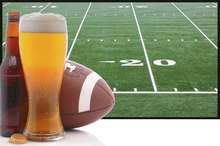Muscle Atrophy Due to Alcoholism
Muscle atrophy is defined by the loss or wasting of muscle tissue 2. There are several causes, including a lack of physical activity or disease. Neurogenic atrophy is the most severe form of muscle atrophy and occurs more suddenly 2. This can result from a number of severe medical conditions such alcoholism.
Alcoholism
Alcoholism is the third most prevalent disease after heart disease and cancer. According to a study published in "The Lancet," approximately one out of ever 25 deaths around the world are related to alcohol consumption 4. Alcoholism is also linked to a number of life-threatening health problems like liver failure, gastrointestinal problems, weakened immune system and metabolic bone diseases. The risk of painless and progressive muscle wasting is much higher in alcohol abusers as well.
- Alcoholism is the third most prevalent disease after heart disease and cancer.
- The risk of painless and progressive muscle wasting is much higher in alcohol abusers as well.
Muscle Atrophy
About Muscle Tremors After Cancer Treatments
Learn More
Alcohol decreases the amount of blood flow to muscles like the heart, which weakens them and may potentially lead to muscle death. Weakening of the muscles in the heart can lead to disorders like cardiomyopathy, where the heart beats slugglishly. Alcohol also inhibits the repair of lost or damaged muscle, thus making it difficult to completely recover.
Statistics
According to a study published in the "American Journal of Physiology, Endocrinology & Metabolism," skeletal muscle atrophy is common among as many as two-thirds of alcohol abusers 2. Women tend to be more susceptible to skeletal muscle atrophy 2. Skeletal muscle atrophy is further exacerbated by malnutrition, which is also common among alcohol abusers 2.
Diagnosis and Treatment.
How Many Situps Does it Take to Burn One Pound of Fat?
Learn More
Muscle atrophy can be diagnosed using blood tests, CT scans, electromyography, MRI scans or with a muscle or nerve biopsy 2. It is often treated with an exercise program to rehabilitate the muscle. Water exercises can gradually help strengthen and reduce the amount of stress and workload on weak muscles. Other forms of treatment include ultrasound therapy and surgery.
- Muscle atrophy can be diagnosed using blood tests, CT scans, electromyography, MRI scans or with a muscle or nerve biopsy 2.
- It is often treated with an exercise program to rehabilitate the muscle.
Related Articles
References
- MedlinePlus: Alcoholic Neuropathy
- MedlinePlus: Muscle Atrophy
- BBC News: Alcohol Links to One in 25 Deaths
- U.S. National Library of Medicine MedlinePlus. Muscle atrophy. Updated November 22, 2017.
- Adams V. Electromyostimulation to fight atrophy and to build muscle: facts and numbers. J Cachexia Sarcopenia Muscle. 2018;9(4):631–634. doi:10.1002/jcsm.12332
- Muscle atrophy. MedlinePlus.
Resources
Writer Bio
Based in Los Angeles, Calif., Kiki Michelle has been writing health-related articles since 2007. Her work has appeared in "Environmental Science and Technology Magazine." Michelle holds a Bachelor of Arts in human biology from Stanford University.








